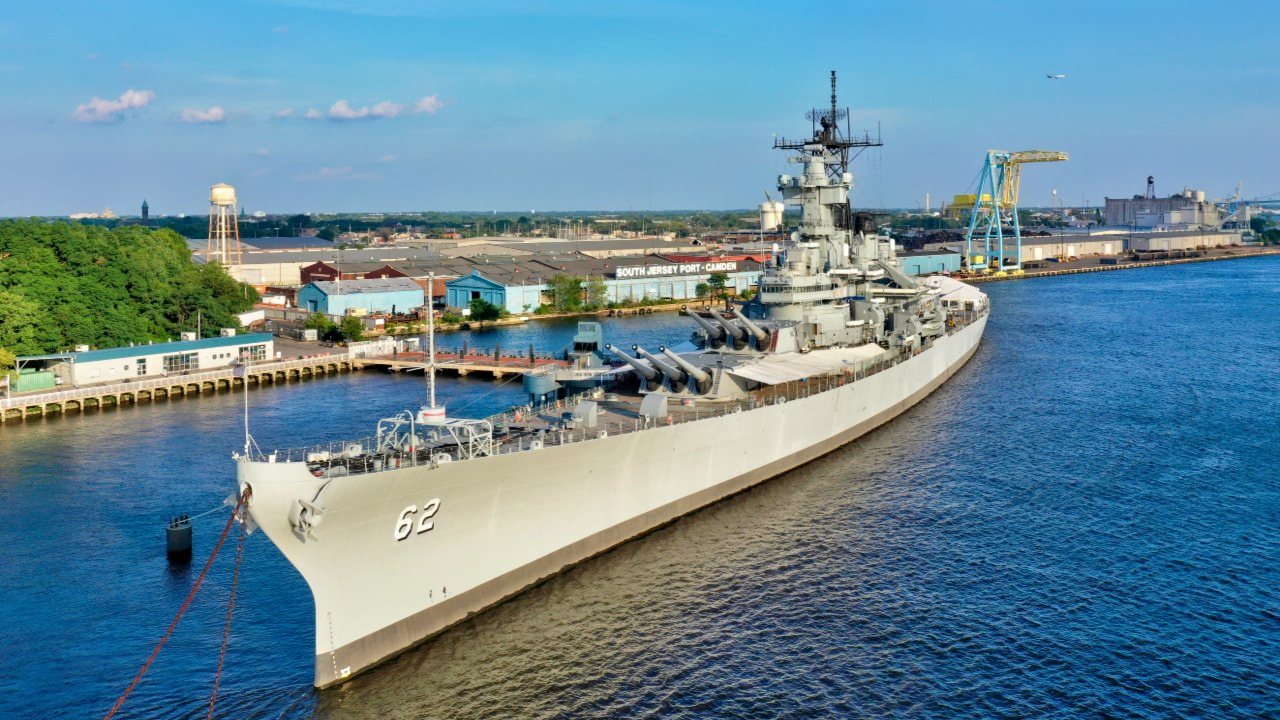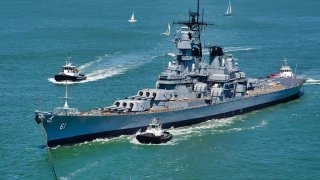Forget Any Chance of the Iowa-Class Battleships Making a Comeback
Beyond the fact that the USS New Jersey and her Iowa-class sister battleships would make gigantic targets, the reality is that smaller ships can do the same job. A bigger issue is that the U.S. Navy – like most of the other branches of the U.S. military – is struggling to meet recruiting goals.
Summary: The USS New Jersey (BB-62), an iconic Iowa-class battleship and the most decorated in U.S. Navy history, is currently undergoing significant restoration at the Philadelphia Naval Shipyard to ensure its continued role as a museum vessel. Amidst this restoration, speculative discussions have emerged about the feasibility of returning such battleships to active service as a counter to modern anti-access/area denial (A2/AD) threats, particularly from nations like China. However, this notion faces steep practical challenges.
Iowa-Class Comeback? Dream On...
The former United States Navy Iowa-class battleship USS New Jersey (BB-62) is now undergoing a fairly major restoration at the Philadelphia Naval Shipyard where she was first launched on December 7, 1942. The efforts are underway to ensure that the famous warship – the most decorated in U.S. Navy history – will continue to serve as a museum vessel for generations to come.
The fact that the ship is receiving a significant makeover has led to no shortage of speculation that she could be returned to service.
As Brandon J. Weichert wrote for The National Interest last month, "Some battleship aficionados even yearn for the old battle wagons to return to fleet service yet again. This time as heavily armored and armed weapons platforms that will punch through the growing anti-access/area denial (A2/AD) capabilities of American adversaries (notably China). The argument is that the primary method of the US Navy's power projectionaircraft carrierswill be deterred from committing to a fight in which these expansive A2/AD systems are present."
Weichert went on to add, "This is, of course, wishful thinking."
The dreams of a battleship sailing are just that, dreams, perhaps even fantasies at best.
The U.S. Navy Lacks Battleship Sailors
Beyond the fact that the USS New Jersey and her Iowa-class sister battleships would make gigantic targets, the reality is that smaller ships can do the same job. A bigger issue is that the U.S. Navy – like most of the other branches of the U.S. military – is struggling to meet recruiting goals.
In other words, the U.S. Navy doesn't have the personnel to operate a battleship, let alone three. This would be putting a lot of sailors on one ship. Those sailors shouldn't be seen as easily replaceable, but that's a moot point because simply put – they're not Battleship Men or Women (although technically women never served on battleships in the first place).
The Iowa-class battleships were retired in the early 1990s, a point that really needs to be stressed.

Today's U.S. Navy warships are commanded by men and women who are from Generation-X and even some Millennials. The crews are made up of some Gen-Xers but the bulk of those men and women are Millennials and Generation Z. In other words, there aren't really the junior officers and NCOs that have any experience serving on a battleship.
A vast majority of today's U.S. Navy sailors weren't even born when the Iowa-class battleships became museums.
There have been reports that Russia may now lack enough trained sailors for carrier operations if its problem-plagued flagship the Admiral Kuznetsov ever manages to return to service – and that aircraft carrier has only been out of service since 2017.
It takes skilled sailors to help train the next generation. The Russian Navy may lack the sailors with any knowledge of naval aviation, but the U.S. Navy lacks trained sailors that have ever served on a battleship. It is true today's Nimitz-class and Gerald R. Ford-class supercarriers are larger than the Iowa-class, so surely there are the sailors that could handle such a ship, but they're not really trained for operating a carrier.
Warships are evolutionary platforms building on the former one. Returning a battleship to service would be a step backward.
There is No Battleship Industrial Base
Another consideration is that the United States Navy is struggling to maintain its current fleet. Converting the Iowa-class back into operational warships would take years, possibly a decade or more. There simply aren't the facilities to even handle such an endeavor.
Even if that wasn't an issue, it would still require upgrading everything, as the ships were last returned to service when Ronald Reagan was in the White House. They're not wired for modern computer systems or outfitted with any current navigation platforms. The warships are hopelessly out of date, and it would cost millions (possibly billions) to see them modernized.
That money could be far better put to submarines, destroyers, and advanced aircraft than restoring relics to operational service.
Yet, even if the money were to magically appear, the U.S. doesn't have a battleship industrial base – meaning the companies that make the plethora of specialized parts needed to restore and then maintain the ships.
In the early 1980s, when the U.S. Navy reactivated the four Iowa-class battle wagons, parts were cannibalized from other retired battleships including the USS Alabama (BB-60), USS Massachusetts (BB-59), and USS North Carolina (BB-55). Probably everything of value was already taken then, and what wasn't likely hasn't aged well. Simply put, there aren't the major components in some mythical naval yard just waiting to restore the Iowa-class.
There may be some old military platforms that have endured the test of time – the B-52 Stratofortress being one – but the sun has set on the battleship. It is time to put any talk of it ever being returned to service to rest.
Author Experience and Expertise: Peter Suciu
Peter Suciu is a Michigan-based writer. He has contributed to more than four dozen magazines, newspapers, and websites with over 3,200 published pieces over a twenty-year career in journalism. He regularly writes about military hardware, firearms history, cybersecurity, politics, and international affairs. Peter is also a Contributing Writer for Forbes and Clearance Jobs. You can follow him on Twitter: @PeterSuciu.
You can email the author: [email protected].
Image Credit: Creative Commons.


